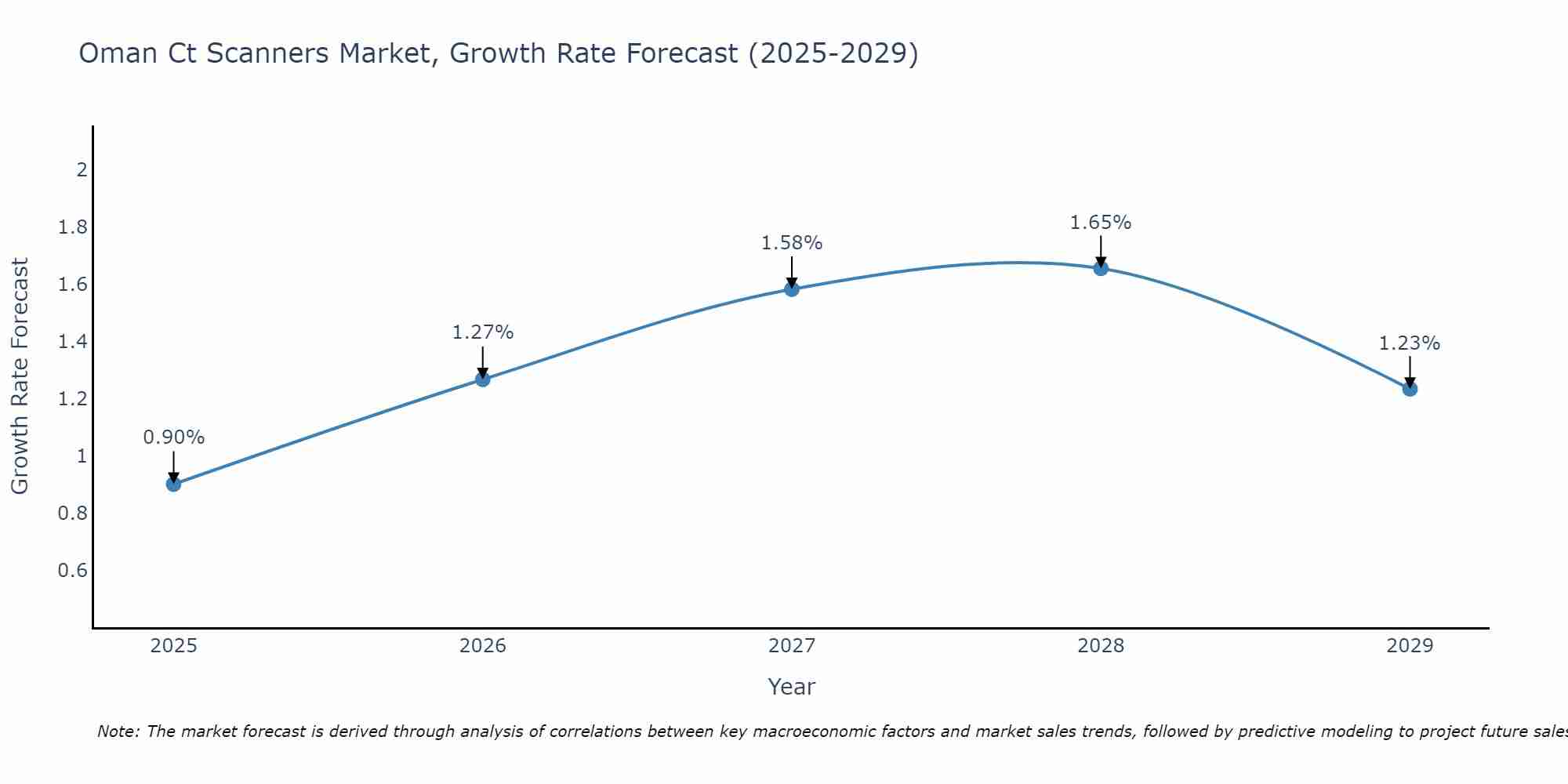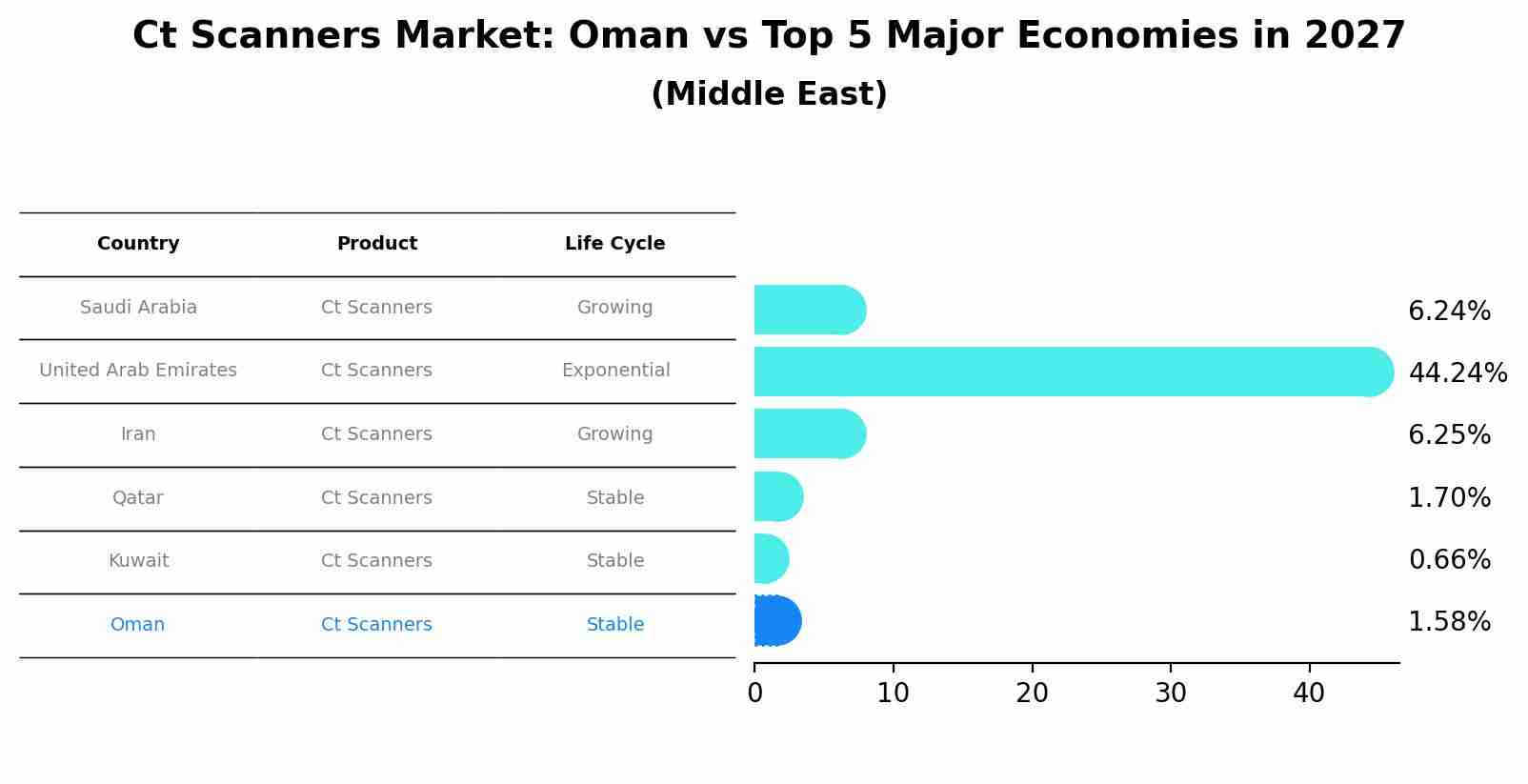Oman Ct Scanners Market Outlook | Analysis, Industry, COVID-19 IMPACT, Growth, Forecast, Revenue, Size, Trends, Companies, Share & Value
| Product Code: ETC362803 | Publication Date: Aug 2022 | Updated Date: Aug 2025 | Product Type: Market Research Report | |
| Publisher: 6Wresearch | Author: Vasudha | No. of Pages: 75 | No. of Figures: 35 | No. of Tables: 20 |
Oman Ct Scanners Market Size Growth Rate
The Oman Ct Scanners Market is projected to witness mixed growth rate patterns during 2025 to 2029. Growth accelerates to 1.65% in 2028, following an initial rate of 0.90%, before easing to 1.23% at the end of the period.

Ct Scanners Market: Oman vs Top 5 Major Economies in 2027 (Middle East)
By 2027, Oman's Ct Scanners market is forecasted to achieve a stable growth rate of 1.58%, with Saudi Arabia leading the Middle East region, followed by United Arab Emirates, Iran, Qatar and Kuwait.

Oman Ct Scanners Market Synopsis
The Oman CT scanners market is experiencing steady growth driven by increasing healthcare infrastructure development, rising prevalence of chronic diseases, and growing investment in advanced medical technologies. Government initiatives to improve healthcare services, along with a growing elderly population requiring diagnostic imaging, are also contributing to market expansion. Private healthcare providers are investing in modern CT scanner technology to enhance diagnostic capabilities and improve patient care. Key players in the Oman CT scanners market are focusing on technological advancements such as AI integration, faster scanning speeds, and lower radiation doses to gain a competitive edge. The market is expected to continue growing as healthcare facilities strive to meet the increasing demand for advanced diagnostic imaging services in the country.
Oman Ct Scanners Market Trends
The Oman CT scanners market is experiencing a trend towards advanced technology and increased demand for diagnostic imaging services. There is a growing preference for multi-slice CT scanners due to their higher speed and improved image quality, allowing for more detailed and accurate diagnoses. Providers are also focusing on enhancing patient comfort and safety through features such as lower radiation doses and faster scan times. The market is seeing a rise in the adoption of portable and mobile CT scanners, particularly in remote or rural areas where access to imaging facilities is limited. Overall, the Oman CT scanners market is evolving towards more efficient and patient-centric solutions to meet the growing healthcare needs of the population.
Oman Ct Scanners Market Challenges
In the Oman CT scanners market, some of the key challenges include limited healthcare infrastructure in certain regions, leading to unequal access to CT scanning services across the country. Additionally, the high cost associated with purchasing and maintaining CT scanners can be a significant barrier for healthcare facilities, particularly smaller clinics and hospitals. Another challenge is the shortage of skilled radiologists and technicians trained in operating and interpreting CT scans, which can impact the quality and efficiency of diagnostic services provided. Moreover, regulatory hurdles and import restrictions on medical equipment in Oman can also pose challenges for companies looking to enter or expand in the CT scanners market. Addressing these challenges will require strategic investments in healthcare infrastructure, training programs, and regulatory reforms to foster growth and innovation in the CT scanners market in Oman.
Oman Ct Scanners Market Investment Opportunities
The Oman CT scanners market presents several investment opportunities due to the increasing demand for advanced medical imaging technologies in the country. With a growing population and rising healthcare expenditure, there is a need for state-of-the-art CT scanners to improve diagnostic capabilities and patient outcomes. Potential investment opportunities include partnering with healthcare facilities to supply CT scanners, investing in distributorship agreements with leading CT scanner manufacturers, or establishing a service and maintenance business for existing CT scanner installations. Additionally, focusing on providing training and education programs for healthcare professionals on CT scanner usage and interpretation could be a lucrative investment avenue in the Oman market. Overall, investing in the Oman CT scanners market offers potential for growth and profitability in the rapidly evolving healthcare sector.
Jordan Agar Market Government Policies
In Oman, the government has implemented policies related to the regulation and licensing of medical equipment, including CT scanners, to ensure quality and safety standards are met. The Ministry of Health oversees the registration and approval process for CT scanners to be used in healthcare facilities, with strict guidelines on maintenance and calibration requirements. Additionally, there are regulations in place to monitor the pricing and distribution of medical equipment, including CT scanners, to prevent price gouging and ensure accessibility to the population. The government also encourages investment in healthcare infrastructure to improve access to advanced medical technologies like CT scanners across the country, with a focus on enhancing healthcare services for the population.
Oman Ct Scanners Market Future Outlook
The future outlook for the Oman CT Scanners Market appears positive, driven by increasing healthcare infrastructure investments and rising demand for advanced diagnostic imaging technologies. The market is expected to witness steady growth due to factors such as the growing prevalence of chronic diseases, expanding geriatric population, and the government`s focus on enhancing healthcare services. Technological advancements in CT scanner systems, such as the development of high-resolution imaging capabilities and automation features, are likely to further fuel market growth. Moreover, the increasing adoption of CT scanners in various medical specialties, including oncology, cardiology, and neurology, is anticipated to contribute to market expansion. Overall, the Oman CT Scanners Market is poised for growth in the coming years, presenting opportunities for market players to innovate and capitalize on the evolving healthcare landscape.
Key Highlights of the Report:
- Oman Ct Scanners Market Outlook
- Market Size of Oman Ct Scanners Market, 2021
- Forecast of Oman Ct Scanners Market, 2031
- Historical Data and Forecast of Oman Ct Scanners Revenues & Volume for the Period 2018 - 2031
- Oman Ct Scanners Market Trend Evolution
- Oman Ct Scanners Market Drivers and Challenges
- Oman Ct Scanners Price Trends
- Oman Ct Scanners Porter's Five Forces
- Oman Ct Scanners Industry Life Cycle
- Historical Data and Forecast of Oman Ct Scanners Market Revenues & Volume By Type for the Period 2018 - 2031
- Historical Data and Forecast of Oman Ct Scanners Market Revenues & Volume By Stationary CT scanners for the Period 2018 - 2031
- Historical Data and Forecast of Oman Ct Scanners Market Revenues & Volume By Portable CT scanners for the Period 2018 - 2031
- Historical Data and Forecast of Oman Ct Scanners Market Revenues & Volume By Device Architecture for the Period 2018 - 2031
- Historical Data and Forecast of Oman Ct Scanners Market Revenues & Volume By C-arm CT Scanners for the Period 2018 - 2031
- Historical Data and Forecast of Oman Ct Scanners Market Revenues & Volume By O-arm CT Scanners for the Period 2018 - 2031
- Historical Data and Forecast of Oman Ct Scanners Market Revenues & Volume By Technology for the Period 2018 - 2031
- Historical Data and Forecast of Oman Ct Scanners Market Revenues & Volume By High-slice CT for the Period 2018 - 2031
- Historical Data and Forecast of Oman Ct Scanners Market Revenues & Volume By Mid-slice CT for the Period 2018 - 2031
- Historical Data and Forecast of Oman Ct Scanners Market Revenues & Volume By Low-slice CT for the Period 2018 - 2031
- Historical Data and Forecast of Oman Ct Scanners Market Revenues & Volume By Cone-beam CT for the Period 2018 - 2031
- Historical Data and Forecast of Oman Ct Scanners Market Revenues & Volume By Application for the Period 2018 - 2031
- Historical Data and Forecast of Oman Ct Scanners Market Revenues & Volume By Human Application for the Period 2018 - 2031
- Historical Data and Forecast of Oman Ct Scanners Market Revenues & Volume By Diagnostic Applications for the Period 2018 - 2031
- Historical Data and Forecast of Oman Ct Scanners Market Revenues & Volume By Cardiology Applications for the Period 2018 - 2031
- Historical Data and Forecast of Oman Ct Scanners Market Revenues & Volume By Oncology Applications for the Period 2018 - 2031
- Historical Data and Forecast of Oman Ct Scanners Market Revenues & Volume By Neurology Applications for the Period 2018 - 2031
- Historical Data and Forecast of Oman Ct Scanners Market Revenues & Volume By Intraoperative Applications for the Period 2018 - 2031
- Historical Data and Forecast of Oman Ct Scanners Market Revenues & Volume By Veterinary Application for the Period 2018 - 2031
- Historical Data and Forecast of Oman Ct Scanners Market Revenues & Volume By Research Application for the Period 2018 - 2031
- Oman Ct Scanners Import Export Trade Statistics
- Market Opportunity Assessment By Type
- Market Opportunity Assessment By Device Architecture
- Market Opportunity Assessment By Technology
- Market Opportunity Assessment By Application
- Oman Ct Scanners Top Companies Market Share
- Oman Ct Scanners Competitive Benchmarking By Technical and Operational Parameters
- Oman Ct Scanners Company Profiles
- Oman Ct Scanners Key Strategic Recommendations
Frequently Asked Questions About the Market Study (FAQs):
- Single User License$ 1,995
- Department License$ 2,400
- Site License$ 3,120
- Global License$ 3,795
Search
Thought Leadership and Analyst Meet
Our Clients
Related Reports
- Canada Oil and Gas Market (2026-2032) | Share, Segmentation, Value, Industry, Trends, Forecast, Analysis, Size & Revenue, Growth, Competitive Landscape, Outlook, Companies
- Germany Breakfast Food Market (2026-2032) | Industry, Share, Growth, Size, Companies, Value, Analysis, Revenue, Trends, Forecast & Outlook
- Australia Briquette Market (2025-2031) | Growth, Size, Revenue, Forecast, Analysis, Trends, Value, Share, Industry & Companies
- Vietnam System Integrator Market (2025-2031) | Size, Companies, Analysis, Industry, Value, Forecast, Growth, Trends, Revenue & Share
- ASEAN and Thailand Brain Health Supplements Market (2025-2031) | Strategy, Consumer Insights, Analysis, Investment Trends, Opportunities, Growth, Size, Share, Industry, Revenue, Segments, Value, Segmentation, Supply, Forecast, Restraints, Outlook, Competition, Drivers, Trends, Demand, Pricing Analysis, Competitive, Strategic Insights, Companies, Challenges
- ASEAN Bearings Market (2025-2031) | Strategy, Consumer Insights, Analysis, Investment Trends, Opportunities, Growth, Size, Share, Industry, Revenue, Segments, Value, Segmentation, Supply, Forecast, Restraints, Outlook, Competition, Drivers, Trends, Demand, Pricing Analysis, Competitive, Strategic Insights, Companies, Challenges
- Europe Flooring Market (2025-2031) | Outlook, Share, Industry, Trends, Forecast, Companies, Revenue, Size, Analysis, Growth & Value
- Saudi Arabia Manlift Market (2025-2031) | Outlook, Size, Growth, Trends, Companies, Industry, Revenue, Value, Share, Forecast & Analysis
- Uganda Excavator, Crane, and Wheel Loaders Market (2025-2031) | Strategy, Consumer Insights, Analysis, Investment Trends, Opportunities, Growth, Size, Share, Industry, Revenue, Segments, Value, Segmentation, Supply, Forecast, Restraints, Outlook, Competition, Drivers, Trends, Demand, Pricing Analysis, Competitive, Strategic Insights, Companies, Challenges
- Rwanda Excavator, Crane, and Wheel Loaders Market (2025-2031) | Strategy, Consumer Insights, Analysis, Investment Trends, Opportunities, Growth, Size, Share, Industry, Revenue, Segments, Value, Segmentation, Supply, Forecast, Restraints, Outlook, Competition, Drivers, Trends, Demand, Pricing Analysis, Competitive, Strategic Insights, Companies, Challenges
Industry Events and Analyst Meet
Whitepaper
- Middle East & Africa Commercial Security Market Click here to view more.
- Middle East & Africa Fire Safety Systems & Equipment Market Click here to view more.
- GCC Drone Market Click here to view more.
- Middle East Lighting Fixture Market Click here to view more.
- GCC Physical & Perimeter Security Market Click here to view more.
6WResearch In News
- Doha a strategic location for EV manufacturing hub: IPA Qatar
- Demand for luxury TVs surging in the GCC, says Samsung
- Empowering Growth: The Thriving Journey of Bangladesh’s Cable Industry
- Demand for luxury TVs surging in the GCC, says Samsung
- Video call with a traditional healer? Once unthinkable, it’s now common in South Africa
- Intelligent Buildings To Smooth GCC’s Path To Net Zero


















